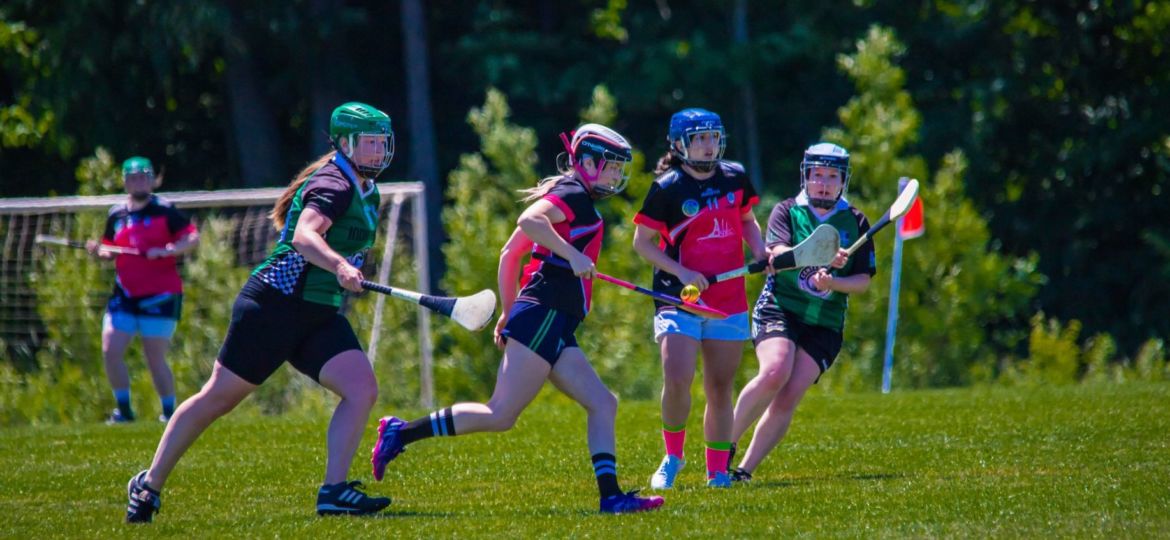
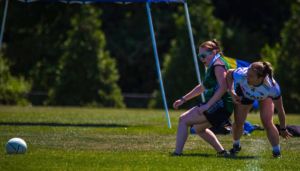
As an adult, Leigh Rusyn has experienced a completely different side to sports than the one that was shown to her when she was a student athlete. Through joining the Indianapolis Gaelic Athletic Association (Indy GAA) and playing sports like hurling, gaelic football, and camogie among many diverse women and men, Rusyn realized that sports don’t always have to be hyper-competitive and full of unnecessary comparisons. We spoke to Leigh to learn more about her experience with the Indy GAA.
Why did you choose to join Indy GAA instead of going to the gym or playing a more traditional sport? Do you have Irish roots?
I moved to Indianapolis from Syracuse, NY in June of 2013. I worked out at the gym a bunch and had my successes there, but always felt like I was missing something. So being in a new city, I really wanted to find a way to make some friends outside of work, but I didn’t really know what clubs were really out there. I happened to be talking with my neighbor, Brien Shoemaker, and he mentioned that he played hurling. He told me about the sport and that he was also the coach of the women’s team. Instead of calling it “women’s hurling” they call it “camogie” (ka-mo-gee). I told him that I played lacrosse and field hockey, and he said I would fit right into hurling, and he was right!
I am like 1/16th Irish, something very small like that. I’ve never been to Ireland, but there are some Irish people in the club. It’s very cool to watch them play; it’s like playing with pros.
Can you explain a bit about hurling and Gaelic football?
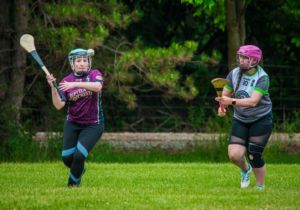
In hurling, you wear a helmet and have a flat stick. It’s similar to a field hockey stick, but it is bigger at the end (a hurley), and the ball is like a baseball (a sliotar). When the ball is on the ground you can hit it on the ground like in field hockey. However, the main way to move the ball is to scoop it up with your stick, get it into your hand, and hit it like a baseball. When the ball comes to you, you should catch it and you can carry it for four steps before you have to either pass it to someone else (either by hitting it like a baseball again, or using a hand pass), or shoot. The goal is a soccer goal with a football field goal over it. If you get it in the goal, it’s three points, and if you get it over the field goal, it’s one point. The score is separated, so you have to do some math to figure out who is winning. (A score might look like: 6-7 to 5-4. The first number is the goals, the second number is the points above the goal).
Gaelic football is very similar, except without the stick and helmet. Gaelic football is like ultimate frisbee and soccer combined. You have a ball, about the size of a soccer ball, that you move down the field. You can kick the ball or catch it and carry it into your hand for four steps before you have to hand pass it to another player, kick it to yourself, or kick it across the field. The scoring is the same as hurling. It’s like watching a soccer game on crack — it’s very fast-paced.
How is playing these sports different from any other sport you played growing up?
Being an adult athlete is much different than being a scholastic athlete. When you’re a kid, there’s a lot of pressure to be the best and be competitive, not just against other teams but also against your teammates. Who’s going to be the starter? Who’s going to score the most goals? Who’s going to get an athletic scholarship?
As an adult athlete, that pressure is gone, and with it, the pettiness. I remember after my second camogie practice someone announced where we were getting drinks afterward, and that’s how I got to know the ladies on my team. They all were happy I came out and they could see I had an athletic mindset and saw I could bring something to the team even if my skills weren’t there yet.
I feel like even in games that are frustrating, everyone is much more positive about the feedback of the game. Instead of focusing on what’s going wrong, we talk about what’s going right and work to do more of that, and oftentimes I think it leads to pretty good results.
What does it mean to you to be a part of such an empowering group of female athletes?
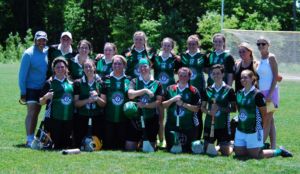
I would say that as an adult, we all realize that other women struggle with the same kind of things. We work hard to motivate each other instead of bringing each other down because we realize that’s what really drives us. Treat yourself how you would like to be treated. Empowered instead of put down. Little victories over big losses. Understand that everyone has busy lives and we try to make our best efforts to show up when we can. We really focus on the game ahead and don’t bring the drama onto the field during the game.
Because we’re a club within such a big club, I think we are a tighter-knit group than some of the other teams within the club. Our team of women loves to play together and I think we mingle with each other well after co-ed games. For our co-ed league, all the ladies are on different teams, but we cheer for each other between games.
What has competing in Gaelic football taught you about yourself?
Playing Gaelic football has taught me that I am conditioned to play sports with a stick in my hand. I never know what to do with my arms in Gaelic football and when the ball comes to me, the act of catching just takes me by surprise.
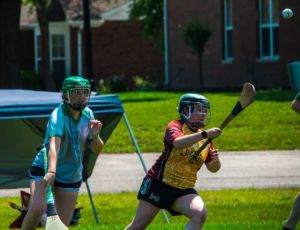
Ladies who played soccer growing up will take to Gaelic football really easily. One thing I do like about it is that it is so fast-paced that it’s a great cardio workout. Like you move much more in Gaelic football than you do in camogie or even soccer.
We had a tournament recently and I told them I was not going to play Gaelic football, but as I arrived at the field one of our players got injured and they needed a replacement, and I jumped in to help. And I think it taught me that I was able to take risks and really step up for my team when they needed me.
If you are interested in learning more about hurling or Gaelic football, you can visit indygaa.com or follow @indygaa on Facebook and Instagram.
Photo of the camogie team by Brittney-Elizabeth Photography.
Mina Denny is Indy Maven’s editorial intern. You can connect with her on Twitter and on LinkedIn.
All of our content—including this article—is completely free. However, we’d love it if you would please consider supporting our journalism with an Indy Maven membership.






